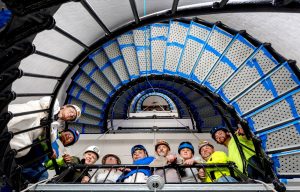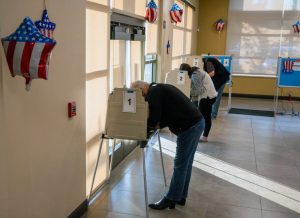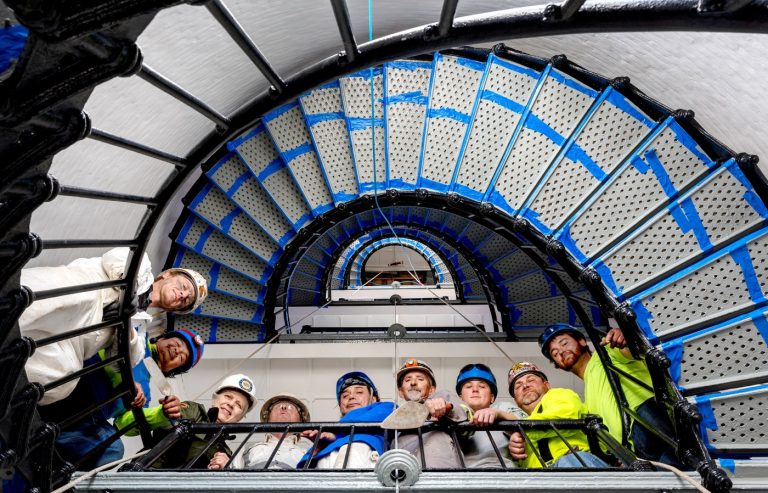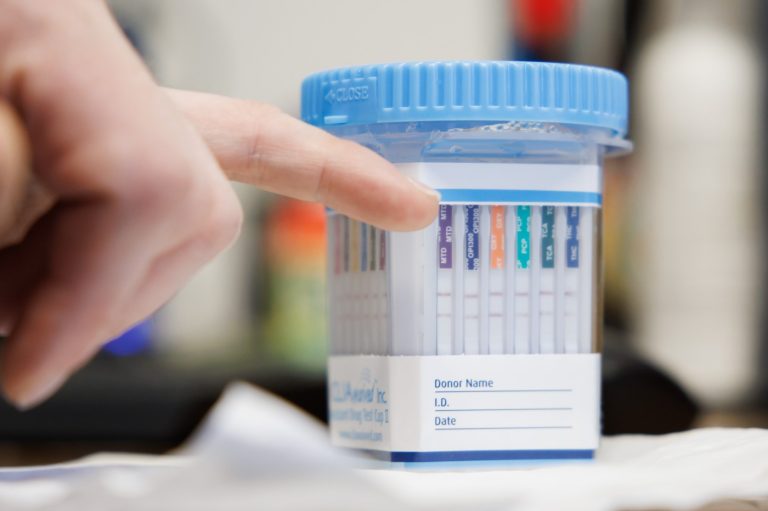For what seems to be the first time in decades, nuclear energy is having a moment.
Recent headlines announcing plans to restart old power plants, along with anticipation of the development of nuclear facilities with more compact designs, plus expected increases in energy demand spurred largely by data centers to meet anticipated growth of artificial intelligence networks have given the nuclear industry and its advocates a boost.
And in what may be a long shot, some proponents even think nuclear can make a comeback in California, where opponents have long been entrenched.
“In general, nuclear advocates are euphoric,” said Mark Nelson, managing director at the Radiant Energy Group, a clean power consultancy that avidly supports nuclear power. “It’s an enormous amount of energy in a tiny amount of space, requiring almost no mining or extraction of the earth’s resources without emitting carbon, 24/7 and can last a hundred years or more at a single power plant.”
RELATED: Silicon Valley has a plan to save humanity: Just flip on the nuclear reactors
But the industry still has fierce critics who say any claims of a nuclear renaissance are overblown.
“We would call it a relapse” rather than a revival, said Kevin Kamps, radioactive waste specialist at Beyond Nuclear, a nonprofit opposed to nuclear power that is based in Maryland. “There have been other nuclear so-called boom cycles, so we’re very skeptical of the propaganda.”
Signs of new life
Perhaps the most dramatic example of a potential comeback came last month when Microsoft announced plans to restart a portion of Three Mile Island — the site of the 1979 accident that delivered a near-fatal blow to the industry.
Microsoft unveiled a $1.6 billion power purchase agreement with Constellation Energy to bring back the Unit 1 reactor in 2028 as a dedicated source of emissions-free electricity to feed a fleet of Microsoft data centers.
Like many tech companies, Microsoft is making a huge bet on artificial intelligence.
Generative AI processes gigabytes of data, scans billions of words and uses models that adaptively learn over time, which requires huge amounts of electricity from data centers.
Just 10 days after the Three Mile Island announcement, the U.S. Department of Energy finalized a $1.5 billion low-interest loan guarantee to help reopen the Holtec Palisades nuclear power plant in Michigan.
The energy department expects electricity demand to grew 15 percent in the next few years, driven by growth in data centers for AI, more electric vehicles on the road and an increasing reliance on continuous power such as nuclear that can complement variable energy sources such as wind and solar.
On top of that, 14 of the world’s top financial institutions, including Goldman Sachs and Bank of America, announced last month they would lend money to help triple global nuclear energy capacity by 2050.
“It is essential that we accelerate the progression of planned projects into plants on the ground given the huge demand coming down the line for data centers and AI technologies,” James Schaefer of Guggenheim Securities said in a statement.
Let’s get small
While large nuclear power plants, such as the now-shuttered San Onofre Nuclear Generating Station, have been the norm for decades, there’s been a movement toward developing more compact facilities.
Small modular nuclear reactors, known as SMRs for short, can be prefabricated in several pieces, shipped to a given location and assembled on the site, reducing the onerous capital costs that often prevent larger plants from being built.
Generally, SMRs are about 300 megawatts or less — about one-third the size of a conventional nuclear power plant.
SMR technology is still in its early days but Oracle announced last month it will build a data center powered by three small reactors — although the company did not specify the project’s location nor the company that will build it, perhaps underscoring the uncertainty of the nascent industry’s development.
Earlier this week, Google announced plans to purchase energy from multiple SMRs that Alameda-based startup Kairos Power anticipates bringing online starting in 2030. Google cited the need for “new electricity sources to support AI technologies” and that nuclear can “offer a clean, round-the-clock power source that can help us reliably meet electricity demands.” But similar to the Oracle deal, the Google-Kairos announcement did not disclose pricing and locations.
At least 25 companies are developing SMRs, including TerraPower, founded by billionaire Bill Gates.
Diablo stays open
But one of the most significant events happened two years ago when California Gov. Gavin Newsom reversed himself and promoted legislation that eventually extended the life of the Diablo Canyon nuclear power plant near San Luis Obispo through 2030 at least.
Newsom’s decision was prompted by concerns that closing the nuclear plant threatened the reliability of state’s power grid. In August 2020, the state experienced two consecutive days of rotating power outages, with some areas blacked out up to 2 1/2 hours.
The Diablo Canyon nuclear power plant, operated by Pacific Gas & Electric, got a reprieve from Gov. Gavin Newsom and the California Legislature to keep operating through 2030. (AP Photo/Michael A. Mariant)
“The anti-nuclear movement came out of California; the environmental movement came out of California,” said Nelson of the Radiant Energy Group. “For California to decide to keep nuclear power is therefore a clarion call to the world.”
By itself, Diablo generates 17% of the state’s zero-carbon electricity and accounted for 9.34% of California’s power mix in 2023.
There also seems to be an increase in popular opinion for nuclear.
Annual surveys by the Pew Research Center have shown the percentage of U.S. adults in favor of more nuclear power plants to generate electricity has increased from 43% in 2020 to 56% in May of this year.
And a separate poll released in August from a group called America in One Room, said four out of five young American voters support “new generation” nuclear energy to supplement renewable power sources.
The results do not surprise Josh Freed, senior vice president for climate and energy at Third Way, a center-left think tank based in Washington D.C. that supports nuclear power as a tool to fight climate change.
“Young people have grown up in an era of significant technological change and they’re comfortable with different types of sophisticated technology,” Freed said. “The anti-nuclear movement was at its peak in the late 1970s and it’s ancient history to many (young) people because it was before their time.”
Opponents still dug in
But some say all the talk of a nuclear comeback represents a false hope.
For one thing, the much-ballyhooed openings of two new state-of-the-art reactors at the Plant Vogtle facility in Georgia in 2023 and 2024 arrived seven years behind schedule and $17 billion over projected costs.
And just a week after the loan guarantee was announced to reopen the Holtec Palisades plant, it was discovered that corrosion cracking in steam generators “far exceeded” estimates. Despite the findings, a Holtec spokesman told Reuters the company still plans to restart the Michigan plant on schedule.
Opponents say it’s indicative of the problems — and expense — inherent in running nuclear power plants.
“Nuclear projects are large and complicated and they take a long time to build,” said Tim Judson, executive director of the Nuclear Information and Resource Service that bills itself as a group fighting for a nuclear-free, carbon-free future.
“In fact, delays in construction compound the cost increases because the interest rates on the loans really start to increase the overall cost” to build or upgrade nuclear facilities, Judson said at a press briefing earlier this month titled, “Why Latest Nuclear Revival is Already Doomed.”
Then there’s the persistent question about where to put the 90,000 metric tons of spent nuclear fuel that has accumulated over the years at commercial power plants across the country. Even though it’s the responsibility of the federal government, no repository has ever opened to receive the waste.
A giant underground permanent facility was near completion at Yucca Mountain in southern Nevada but the Obama administration cut off funding for the site in 2010, following years of protests from lawmakers in the Silver State who opposed it. The project’s costs came to at least $15 billion.
There has been an effort to find communities willing to store the waste on an interim basis but two potential sites have run into legal problems.
The 5th U.S. Circuit Court of Appeals ruled the Nuclear Regulatory Commission exceeded its authority when it granted a license for a private company seeking to construct an interim storage facility in West Texas.
The U.S. Supreme Court earlier this month said it will hear the case, which also affects a similar project proposed in eastern New Mexico. A decision by the high court is expected to come in the summer of 2025.
Opponents say investing in nuclear will divert investments in energy sources such as solar and wind, supplemented by battery storage.
“We have limited time and limited money to turn this climate crisis around,” Kamps of Beyond Nuclear said. “So we really need the best ideas and that’s renewables, storage and efficiency, not nuclear. It’s a money pit.”
A comeback … even in California?
Diablo Canyon is the only nuclear power plant still operating in California.
The San Onofre Generating Station has not produced electricity since 2012 after a leak in a steam generator tube led to its closing. The plant, known as SONGS for short, is in the fourth year of a $4.7 billion project to dismantle the facility, which is scheduled to wrap up by the end of 2028.
But some nuclear advocates are optimistic that new projects will come back to the Golden State some day.
Some foresee Silicon Valley tech companies mimicking Microsoft’s strategy at Three Mile Island to use nuclear as a dedicated energy source to power data centers in California. Gene Nelson, president of Californians for Green Nuclear Power, even envisions a nuclear future at San Onofre.
That’s because even after the shuttered plant off Interstate 5 is dismantled, a switchyard with power lines and a substation without transformers will remain at the site because it houses electricity infrastructure that provides a key interconnection for the region’s grid.
“You don’t have to build that infrastructure,” Nelson said. “You just gotta build the power plants. You’ve already got the switchyard.”
The dry storage facility at the San Onofre Nuclear Generating Station, as seen on Nov. 30, 2021. The stainless steel canisters hold some of the 3.55 million pounds of nuclear waste at the facility. (Nelvin C. Cepeda / The San Diego Union-Tribune)
But there’s a hurdle.
According to a state law passed in 1976, no nuclear plants in California can be built until the federal government shows it can sufficiently deal with reprocessing fuel rods and finds a permanent disposal site for nuclear waste.
Since there is no repository on the horizon, the 1976 law, for all practical purposes, amounts to a moratorium on new nuclear facilities in California.
Related Articles
When will election results be available to California residents? Here’s what to know
UC Santa Cruz police seize phone of student suing over pro-Palestine expulsions
Unions pour huge amount of cash into pivotal Oakland city attorney election
Prosecutors will not file criminal charges against 2 people at center of Los Angeles racism scandal
San Jose official condemns councilmember’s comments amidst criminal probe
Nuclear advocates such as Mark Nelson of Radiant Energy says California can simply change the law.
“Citizen movements across the country have gotten rid of these moratorium and phase-out laws all over — from the coal states to the nuclear states,” he said. “If California (lawmakers) got rid of it, they would find a way to spin it as being leaders and we would pat them on the back and say, ‘You did it, buddy. Good job.’ “
But Charles Langley, executive director at Public Watchdogs, a longtime critic of Southern California Edison’s management at SONGS, said the prospect of building a new nuclear facility in or around San Onofre “would be an atrocious, horrific idea.”
Some 3.55 million pounds (or about 1,610 metric tons) of waste is stored in dozens of stainless steel canisters at the north end of the plant, between the ocean and Interstate 5.
“It’s a little bit like the sudden revival of Frankenstein’s corpse because everybody really did think that nuclear was done — in part because it’s simply uneconomic because of the regulatory burdens and the high price of safety,” Langley said. “What we need is a renaissance and energy efficiency, not a renaissance of nuclear, because that’s a return to the dark ages of energy.”
Gary Headrick, co-founder of the environmental group San Clemente Green, agrees. “I don’t think it’s worth contemplating using nuclear power for anything until we figure out the waste problem,” he said.
Edison officials say more than 80 percent of the canisters at SONGS could be taken off-site now if a permanent or interim storage facility existed and 100 percent of canisters will be ready to be shipped by 2030.












